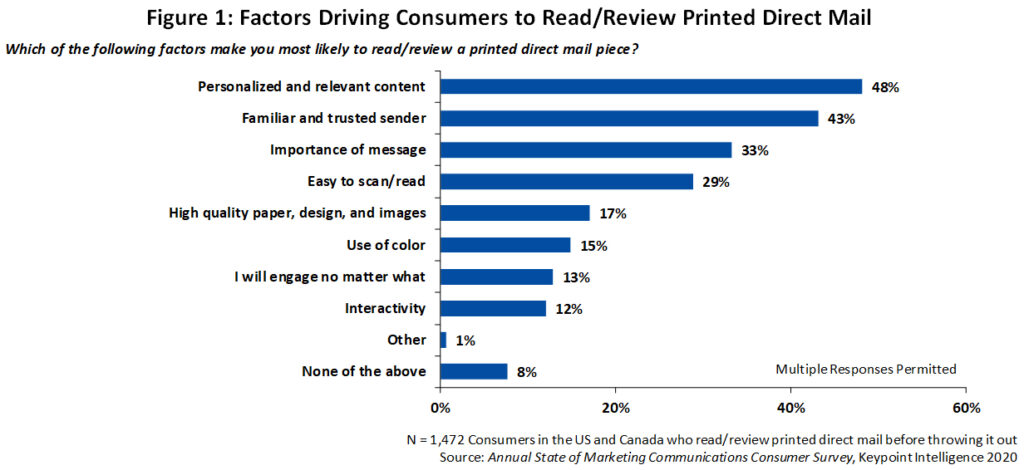What Makes a Consumer Engage with Direct Mail?
By Jim Hamilton, Consultant Emeritus at Keypoint Intelligence
 Any printer that offers direct mail services needs to understand what makes consumers engage with the mail they receive. Industry research tells us that consumers consider physical mail to be an important and trusted vehicle for communications. Consumers also tell us that when and how they receive promotions is a key factor in their purchasing decisions.
Any printer that offers direct mail services needs to understand what makes consumers engage with the mail they receive. Industry research tells us that consumers consider physical mail to be an important and trusted vehicle for communications. Consumers also tell us that when and how they receive promotions is a key factor in their purchasing decisions.
According to Keypoint Intelligence’s most recent marketing communications survey, consumers were the most likely to read/review printed direct mail that offered:
- Personalized and relevant content: Nearly 50% of consumers identified the inclusion of personalized and relevant content as a key factor. This aspect ranked highest among all of the factors mentioned.
- A familiar and trusted sender: Consumers in the survey were more likely to read or review a direct mail piece when it came from a sender that they knew and trusted.
- Importance of the message: This relates back to consumers’ top factor of personalized and relevant content.
- Ease of reading/scanning: All mail pieces should be easy to read or scan through. While graphic design and the use of color can play into this, this really speaks more to the intent of the mail piece and how it is conceived and delivered.

It is also interesting to explore the impact that age has on these factors. The top four factors were the same for all age groups, but the oldest respondents ranked them somewhat differently, with more of an emphasis on a familiar & trusted sender and importance of the message. Meanwhile, the youngest respondents were more receptive to interactivity than their older counterparts.
The point about personalized and relevant content deserves some more exploration. Over 50% of respondents to this same survey reported spending much more time with direct mail that was personalized and relevant than they spent with generic communications. This trend holds up well across all age groups, but personalization was a bit more important to the oldest consumers.
A separate question in this survey revealed that the preference for personalized and relevant messaging holds true for consumers whether the message is received in print or as part of a digital marketing campaign. The key takeaway is that consumers will pay more attention to any type of promotional message that is personalized to them.
We can also learn from what consumers tell us about the follow-up actions they take after receiving a piece of printed direct mail. The top reactions include:
- Visiting the sender’s retail store
- Visiting the sender’s website
- Discussing the content with others
- Making a purchase
Older consumers tended to react more positively to printed direct mail than younger ones. For example, 48% of the oldest consumers reported visiting a retail store in response to a direct mail piece, compared to 27% of the youngest consumers.
One of the biggest challenges facing marketers today is how to spread their promotional budget dollars across the many ways they have of contacting clients and prospects. Ultimately, the best contact method will vary based on the type of business and the recipient’s demographics (i.e., age and other metrics). This leads to a high level of uncertainty among marketers about which communication channels to use in today’s multi-channel world. Keypoint Intelligence uses the term “channel fog” to describe this uncertainty.
Contributing to channel fog are incidents of fraud and identity theft relating to personal data and security. Most people and businesses today have personal experience with being hacked. That experience impacts their perception about the reliability and security of digital methods used to deliver promotional information.
On top of this is something we call “channel fatigue,” which in short describes the difficulties that individuals have managing the flood of consumer and business information that they face daily. The causes of channel fatigue primarily stem from three factors:
- Overload: Consumers experience this when an overwhelming amount of communications originate from a single channel.
- Fear: People dread the consequences associated with being hacked and the time they might need to spend recovering.
- Extra work: Maintaining multiple accounts and passwords becomes yet another task added to time-pressed consumers’ very busy schedules.
The challenge facing the direct marketing industry is to address channel fog and fatigue through a measured omni-channel approach that effectively leverages print. Printed mail offers qualities that are lacking in digital methods. For many, print is more credible. It can be read at one’s leisure and also provides a tactile reminder that remains with the consumer until it is thrown away or recycled. Print is also engaging, particularly when it is personalized. In addition, it can drive a variety of actions. Today’s consumers want to receive information that is relevant to them. By delivering personalized and engaging direct mail, communication providers can deliver an integrated omni-channel experience. This is an experience that will speak to customers and prospects, ultimately generating improved results across all age demographics.



